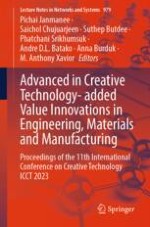The 11th International Conference on Creative Technology (ICCT2023): To Added Value Innovations in Engineering, Materials and Manufacturing was held in Rajamangala University of Technology Krungthep, 2 Nanglinchi Road, Thungmahamek, Sathorn, Bangkok, Thailand, between July 20 and 22, 2023. The conference was organized by three universities from three countries, namely Rajamangala University of Technology Krungthep (RMUTK, Thailand), Vellore Institute of Technology (VIT, India), and Liverpool John Moores University (LJMU, England).
The conference aimed to give an opportunity for students, government organizations, private sectors, and universities to exchange experiences in advances in materials and manufacturing, simulation, automation, optimization of production processes, production management, maintenance, simulation, Industry 4.0, AI, and robotics.
This book presents a collection of 58 peer-reviewed papers. The organizers received 61 contributions from 12 countries around the world. After a thorough peer-review process, the committee accepted 33 papers for conference proceedings prepared by 142 authors from 11 countries (acceptance rate of around 54%).
